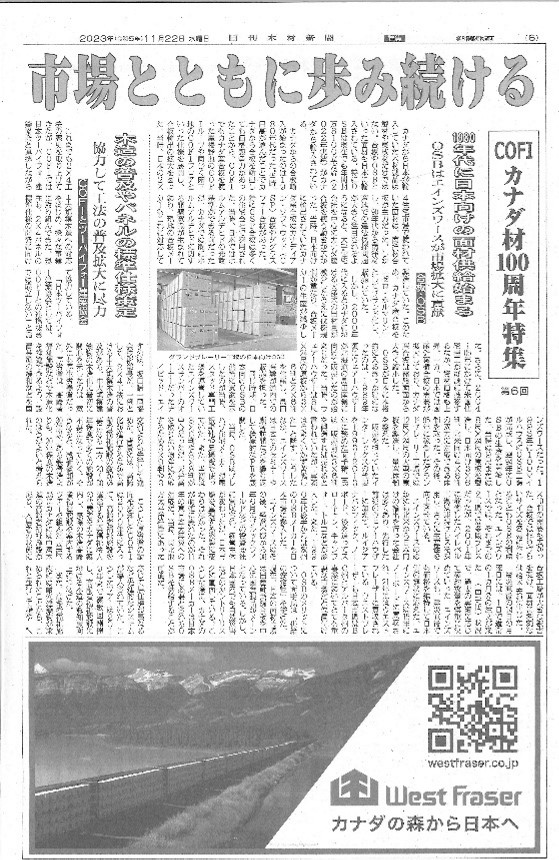Celebrating 100 Years of Wood Trade between Canada and Japan : Part VI (Final)
The sixth and final set of articles in the series commemorating the 100th anniversary of Canada-Japan wood products trade was published on November 22nd in the Nikkan Mokuzai newspaper (Daily Forest Products Journal). These articles have covered the period from 1923 to the present, focusing on the 2×4 construction method, SPF lumber, and the history of Coastal lumber in traditional Post & Beam construction.
The latest articles explore the development of the Canadian structural sheathing market – specifically plywood and OSB – over the past 35 years. They highlight the collaborative efforts between COFI (the Council of Forest Industries) and the Japan 2×4 Home Builders Association in developing technical solutions to enhance the use of 2×4 construction in Japan. Additionally, they discuss Canadian sustainable forestry practices.


The first article delves into the growth of the Canadian softwood and Douglas Fir plywood market in the 1990s. This growth was spurred by concerns over plywood made with illegally logged timber from South-East Asia, which was then the predominant sheathing material in Japan. Rising concerns in Japan about formaldehyde emissions in homes also played a role, as Canadian plywood, known for its low-emission adhesives, became increasingly in demand. The article also tracks the introduction of OSB to the market in 1989. Through extensive efforts, including seminars, company visits, and production adjustments to meet Japanese size requirements, Canadian companies successfully expanded the OSB market.
The second article discusses the longstanding, cooperative relationship between COFI and the Japan 2×4 Home Builders Association. It highlights the development of mid to large-scale wooden structures using the 2×4 method over the past 20 years. This includes the testing and technical development of fire-resistant assemblies, leading to Japanese government certifications for 50 different assemblies. To foster interest in wooden senior care buildings, COFI has organized tours in Canada for Japanese senior facility owners and operators. Currently, COFI and the 2×4 Association are engaged in a 3-year program to develop standard specifications for 2×4 wall panels, aiming to enhance overall panel production efficiency.
Concluding the series, the last article focuses on the sustainable management of Canadian forests. It discusses strict logging and reforestation regulations, the annual allowable cut developed with sustainability in mind, and the considerations required in logging plans by companies with harvesting rights. The article also notes the reforestation efforts in British Columbia, where an average of 280 million trees were planted annually between 2018 and 2021, primarily by university students working part-time during the summer.
For those interested in receiving the translated articles, please contact the writer at [email protected].


